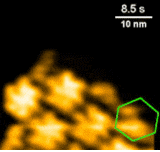Filming viral assembly in real-time
Scientists in Groningen and Madrid have managed to capture unique images of the first steps of virus assembly. By using a very fast scanning probe microscope, they were able to film how HIV proteins begin to form a virus. It appears that the virus forming process does not proceed in a very orderly manner. At first sight, it seems very haphazard. Still, this process eventually leads to a regular virus particle. By figuring out how virus assembly takes place, research can be done in a more focused manner into anti-viral medicines that specifically hinder the forming of the virus.

Human immunodeficiency virus (HIV) causes AIDS, a disease that still results in the deaths of over half a million people per year. HIV packages viral genetic material into a capsule containing virus proteins, among other things. While highly clear images have been taken by electron microscopy that show how the proteins are bound to one another, until recently, no methods have been able to demonstrate how they bind together. After all, electron microscopes cannot capture moving images. However, a very fast atomic force microscope recently entered the market: the High Speed Atomic Force Microscope (HS-AFM), with which videos can be made. This microscope has made it possible to study molecular processes by touch, but scientists had not yet succeeded in following the incredibly dynamic process of virus assembly.
Through intensive collaboration between a research group specializing in HIV at the Universidad Autónoma de Madrid and the Molecular Biophysics research group led by Prof. Wouter Roos at the Rijksuniversiteit Groningen, who have a version of the high-speed microscope in their lab, it became possible to follow virus assembly in real time. ‘A technical masterpiece’, exclaims Prof. Roos from the Zernike Institute for Advanced Materials.
Completing the puzzle
The researchers demonstrated that virus assembly does not proceed in a very ordered manner at all. It appears more like completing a jigsaw puzzle, in which puzzle pieces are added at different spots but also taken away again if they do not appear to fit. In this way, the process seems like an apparently haphazard coming and going of proteins, with some sort logic hidden beneath this. Finally, an ordered grid of proteins is created, which forms the basis of the virus particle. It is likely that other viruses use a similar process to build virus particles.
Coronavirus
The results of the research have been published in the scientific journal ACS Nano. Now that it is clear how the first stages of virus forming take place, the researchers want to shed light on the next steps. In this way, they hope to create a complete image of the process, from the creation of the individual building blocks at the start, to the formation of a whole infectious virus particle. As well as providing fundamental insights into the biology of viruses, this work also has functional applications. Once it is clear how virus particles are made up, highly targeted research can then be done into anti-viral medicines that focus on interrupting the assembly of the AIDS virus. At a later stage, it is also hoped that these methods can be used to investigate other viruses, such as the coronavirus strain that caused the outbreak of COVID-19.
Publication
Alejandro Valbuena, Sourav Maity, Mauricio G. Mateu and Wouter H. Roos
Visualization of Single Molecules Building a Viral Capsid Protein Lattice through Stochastic Pathways
ACS Nano 2020, Vol. 14, p8724–8734, https://pubs.acs.org/doi/abs/10.1021/acsnano.0c03207
For more information, please contact
- UG spokesperson Jorien Bakker, email j.a.bakker@rug.nl.
- Prof.dr. Wouter Roos, email w.h.roos@rug.nl
More news
-
15 September 2025
Successful visit to the UG by Rector of Institut Teknologi Bandung
